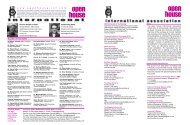Vol :37 Issue No.1 2012 - Open House International
Vol :37 Issue No.1 2012 - Open House International
Vol :37 Issue No.1 2012 - Open House International
Create successful ePaper yourself
Turn your PDF publications into a flip-book with our unique Google optimized e-Paper software.
nition and custom treatment’ at the same time<br />
(Lovelock, 1988). Thus, mass customisation offers<br />
a competitive approach to challenging the more<br />
traditional strategies such as mass production. This<br />
customer-centric approach, selling lifestyle and fantasy,<br />
has featured strongly as the marketing strategy<br />
for myriad categories such as apparel, construction<br />
and home furnishings, computers, sports equipment,<br />
publishing and printing and balloons (Zipkin,<br />
2001).<br />
An earlier paper investigated the notion of<br />
housing mass customisation together with its perceived<br />
implications in Malaysian context (Hamzah<br />
et al, 2010). Following that, the current paper<br />
reports the findings from an empirical study that has<br />
been undertaken to examine the state of market<br />
readiness towards mass customised housing. There<br />
are two major parts to this paper. The first part synthesises<br />
literature related to the study whilst the second<br />
part presents the analysis of the data to report<br />
on whether or not empirical evidence exists to support<br />
the conclusion of demand for mass housing<br />
customisation concept. In the context of the latter, it<br />
is possible to distinguish the two types of data that<br />
has been examined: the first relates to respondents’<br />
perceptions based on their responses with regard to<br />
their system of preferences, and the second is<br />
based on documenting house buyers’ actual choices<br />
of action when it comes to undertaking renovation<br />
works.<br />
THE LITER ATUR E<br />
Central to the evolution of mass customisation in<br />
businesses have been the increased competition<br />
and the drive to win customer loyalty via customer<br />
satisfaction i.e. customer focus. According to Zipkin<br />
(2001), the main enablers to mass customisation<br />
are elicitation, process flexibility and logistics.<br />
Elicitation entails the decision and communication<br />
of customer preference to the producer, aided by<br />
customer-relationship management (CRM) and<br />
automation (IT-based) (Zipkin, 2001). Process flexibility<br />
translates the information into physical product<br />
in high-volume. Pine and Gilmore (1998)<br />
argues that flexibility in both processes and organisational<br />
structures is pivotal to the successful implementation<br />
of mass customisation; it is what distin-<br />
guishes mass customisation from mass production.<br />
Closely related to mass production, flexibility in production<br />
has been enhanced by innovations such as<br />
modular design, lean operations and digital-IT.<br />
Finally, logistics is the stage whereby products manufactured<br />
according to individual customer’s preferences<br />
are delivered to the correct customer.<br />
Lampel and Mintzberg (1996) outline the<br />
spectrum of design and logistic strategies between<br />
pure standardisation and pure customisation in<br />
terms of what each feature is characterised by at<br />
each step along the way. Further, Pine et al (1993)’s<br />
“product-process change matrix” divided into four<br />
the stages in which organisations can operate,<br />
namely invention, mass production, continuous<br />
improvement and mass customisation. It could thus<br />
be argued that mass customisation should come as<br />
a natural progression in the housing sector where<br />
technological innovations have been continuously<br />
experienced.<br />
The implementation of housing mass customisation<br />
in developed economies has been widely<br />
discussed in literature. For instance, Barlow and<br />
Ozaki (2001) highlighted possible demand and<br />
supply side barriers to mass customisation in the UK<br />
which has been adopted since the late 1990s<br />
encompassing building design and service packages.<br />
Among factors mentioned are local authority’s<br />
rigid planning and design guidelines and mortgage<br />
lenders’ apprehension about how innovative<br />
designs could affect future marketability of the<br />
property. In the US, Larson et al (2004) report that<br />
mass customised housing found ready converts<br />
among the sophisticated “baby boomer” generation.<br />
As a result, cutting edge technologies have<br />
been developed in the country to cater for this<br />
demand. An example is the MIT’s automated<br />
design tools (ADT) that facilitate agile and customisable<br />
architectural systems and strategies<br />
which are supported by the current building technology.<br />
In Japan, the discerning Japanese homebuyer<br />
with highly personalised taste has rejected<br />
uniformity (Barlow and Ozaki, 2003). The first mass<br />
customisation system - Sekisui Heim M1 - accepted<br />
user control while also harnessing industrial production.<br />
Van Gassel (2002) provides an insight into<br />
the success of mass customisation in the<br />
Netherlands which is attributable to good institutional<br />
support, particularly in terms of the govern-<br />
1 7<br />
open house international <strong>Vol</strong>.<strong>37</strong> <strong>No.1</strong>, March <strong>2012</strong> Examining The Potential For Mass Customisation... Md. Nasir Daud, Hasniyati Hamzah and Yasmin Mohd Adnan





